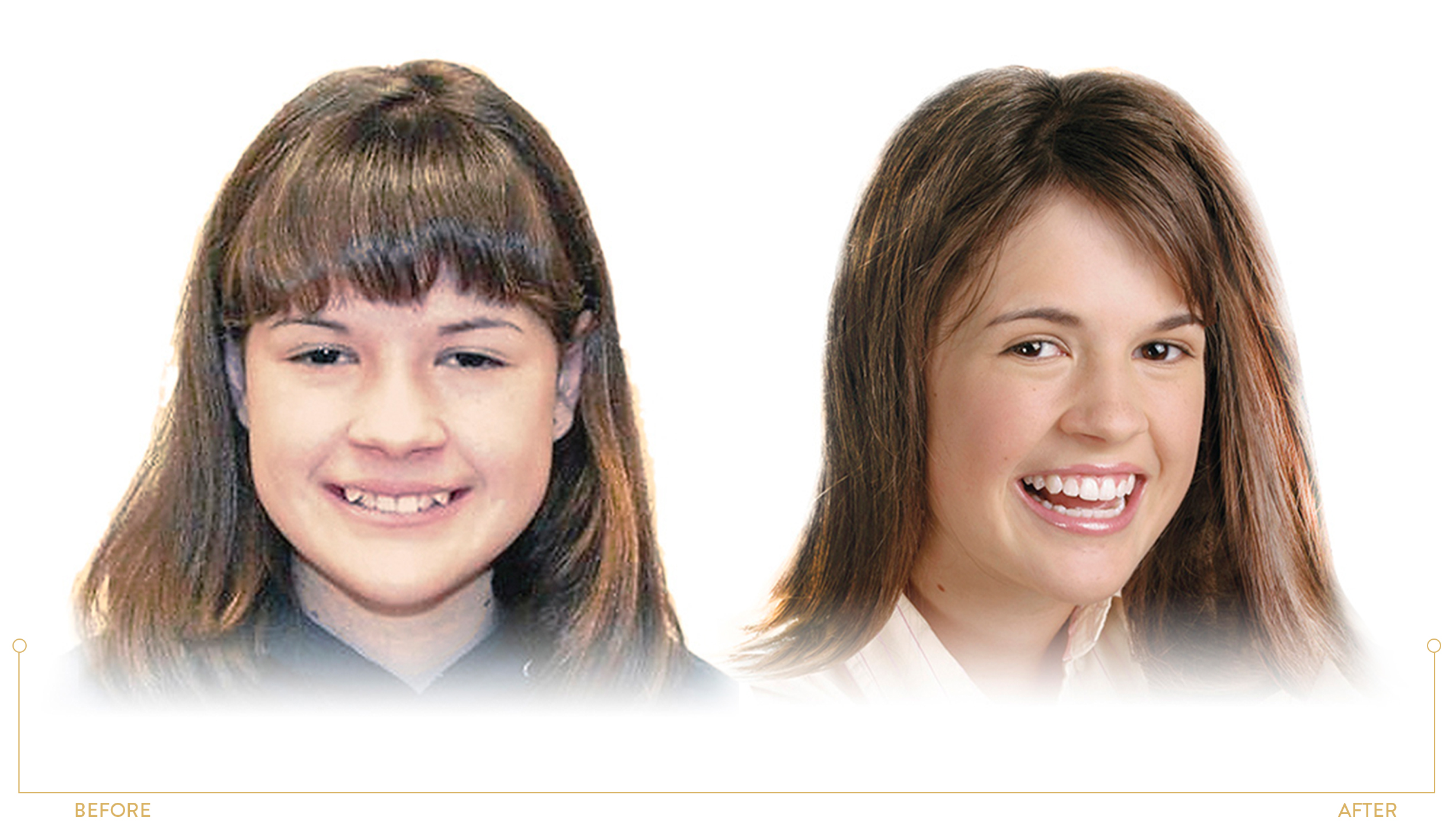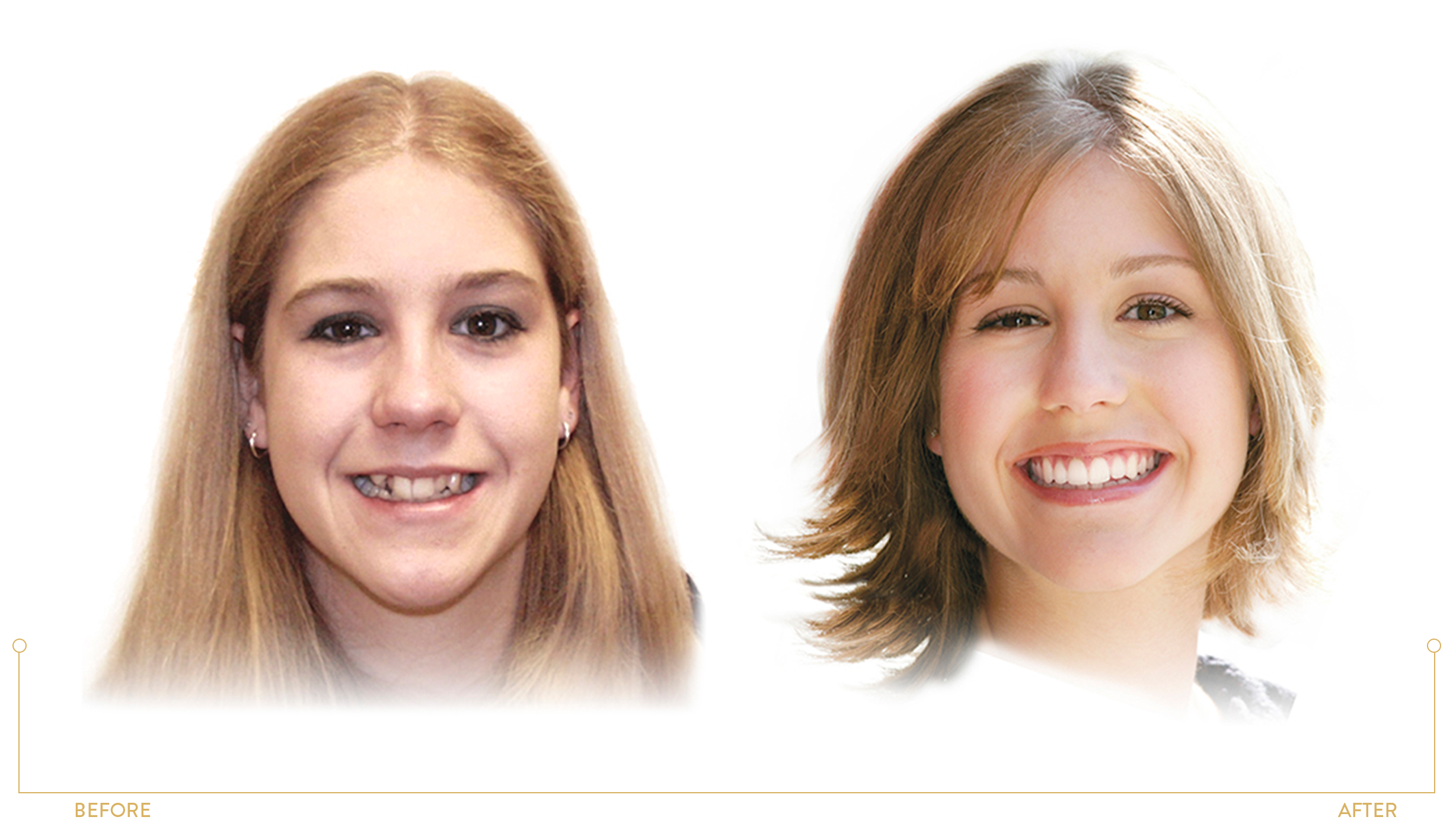Orthodontics – basic information
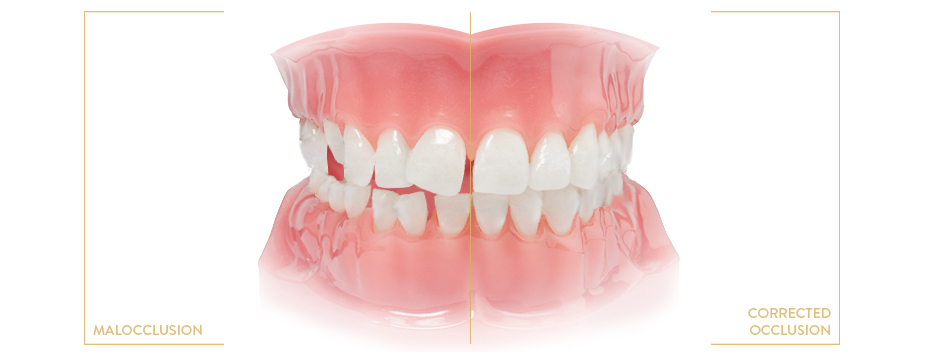
Malocclusion vs corrected Occlussion
What does orthodontics do?
Orthodontics is the field of dentistry responsible for the treatment of malocclusion in children and adults. Properly carried out orthodontic treatment guarantees not only a pretty and aesthetic smile, but also prevents the development of speech impediments, malocclusion, tooth decay, periodontal disease and disorders in the mandibular joint.
The most common indications for orthodontic treatment include:
- crowded teeth
- horizontal maxilla displacement in relation to the mandible
- deep bite
- open bite
- defects of the temporomandibular joint
For patients with missing teeth, orthodontics is often the first stage of implant or prosthetic treatment.
In order to treat malocclusion, orthodontics uses orthodontic appliances. There are many types of orthodontic appliance. Their purpose is to exert pressure on individual teeth so that they move properly within the jaw. Depending on the malocclusion and the age of the patient, the doctor may recommend choosing either a fixed or removable orthodontic appliance.
Orthodontic appliances – types
FIXED ORTHODONTIC APPLIANCE
Modern orthodontics – DAMON system
Cichoń Dental Centre recommends DAMON self-ligating braces, which provide effective and efficient orthodontic therapy. The self-ligating technique is milestone in the development of orthodontics and involves closing the archwire in the slit of the bracket using a special flap, rather than tying it with a ligature (elastic). The arch moves freely, eliminating friction, especially in the initial phase of treatment. For the patient it means a shorter time wearing the device, fewer check-up visits, minimal pain and, most importantly, transverse arch extension, meaning that in most cases there is no need to remove premolars. Hygiene is also easier, since there are no flexible ligatures making it difficult to remove accumulated sediment.
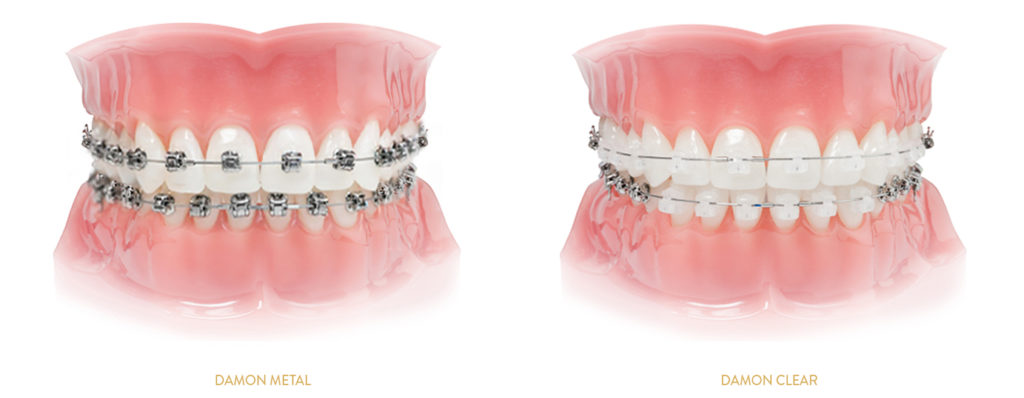
DAMON METAL AND DAMON CLEAR APPLIANCES
System DAMON vs. conventional braces:
- shorter treatment time and fewer check-up visits
- pain reduction to a minimum
- faster improvement of tooth position – effects are visible after the first month
- easier to maintain proper hygiene – no ligatures
- usually without tooth extraction
- more effective treatment for both children and adults

TIME AND NUMBER OF VISITS TO ACHIEVE THE DESIRED TREATMENT EFFECT USING THE DAMON SYSTEM
The Damon system is based on modern brackets and archwires with shape memory, which are delicate for teeth and allow faster movement with fewer corrections. It is a clinically proven technique for straightening teeth and improving facial aesthetics and it speeds up treatment time by as much as six months. It is recommended even for people who have tried traditional orthodontic treatment with unsuccessful results.
TREATMENT EFFECTS WITH THE DAMON SYSTEM
Traditional orthodontic appliances
A metal fixed appliance, also called traditional or ligature-based, is a classic type of fixed orthodontic appliance. It consists of metal brackets connected together by an orthodontic archwire. The apparatus mechanism operates through gentle forces that are exerted by the archwire on the teeth to which the orthodontic brackets are glued. The orthodontic archwire is attached to the brackets using ligatures, and the brackets are glued to the teeth using a special glue.
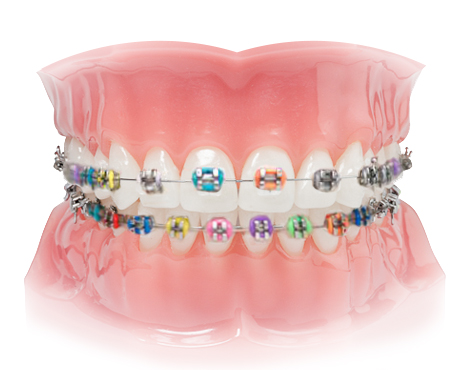
TRADITIONAL appliance WITH elastic LIGATURES
Ligatures (known as elastics) are placed on the slits of the brackets to attach the archwire. The colour of the elastics depends on the patient’s own preferences.
Comparison of fixed appliances
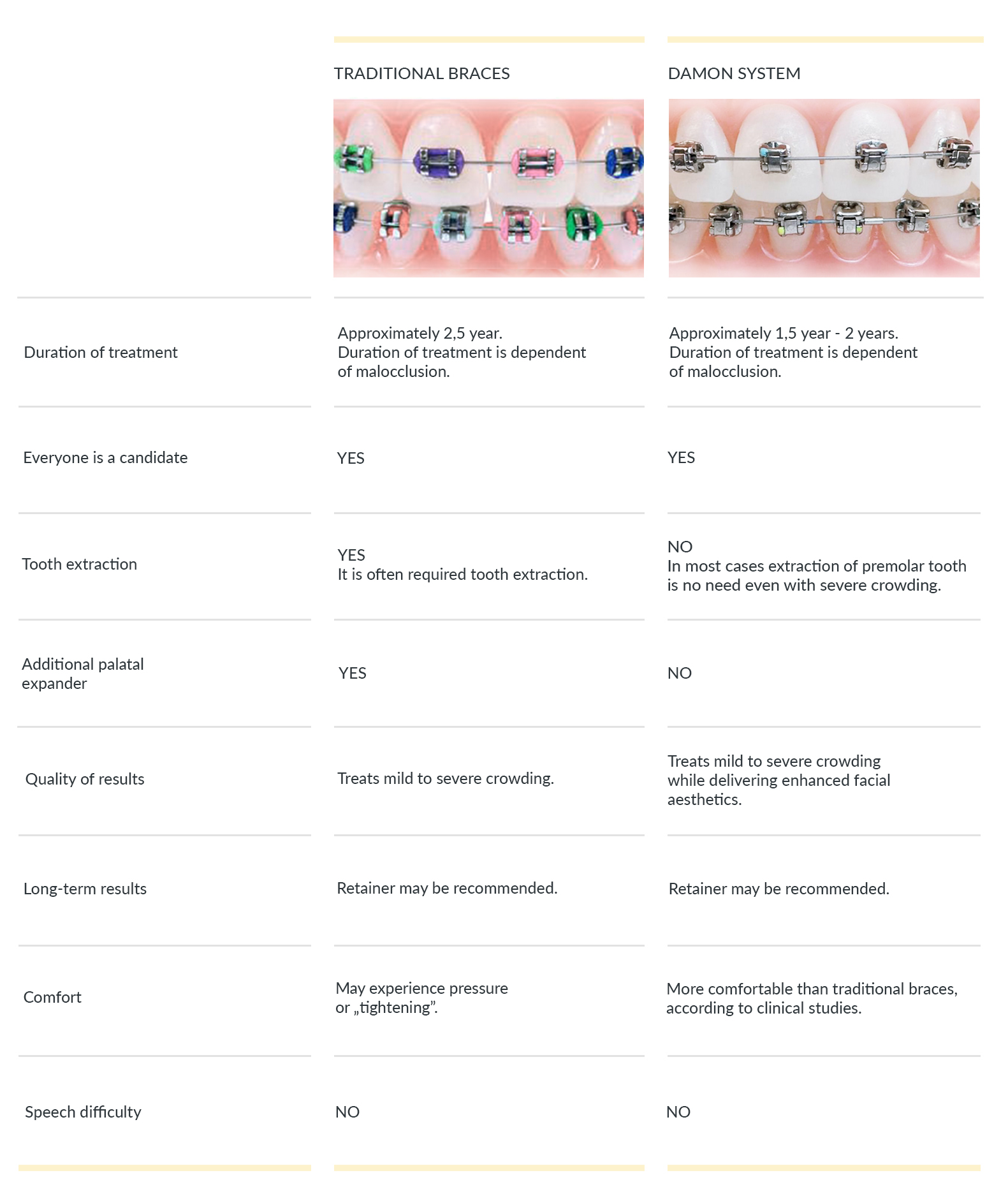
FIXED TRADITIONAL APPLIANCES VS THE DAMON SYSTEM
REMOVABLE ORTHODONTIC APPLIANCES
Trainer orthodontic appliances
Trainers, which are removable appliances, help to expand the dental arches, correct malocclusion and support proper growth of the teeth. They are intended mainly for children during mixed dentition. In rare cases, removable appliances can also be used in adult patients, who are more often recommended much more effective fixed appliances.
Clear aligner
A clear aligner, which is an overlay appliance, is an orthodontic treatment using a transparent tray. It has no brackets or wires. Treatment with a clear aligner device is possible with the help of forces generated by three flexible biocompatible tiles of three thicknesses:
- soft – 0.5 mm
- medium – 0.625 mm
- hard – 0.75 mm
During the treatment, all three plates – soft, medium and hard – have the same shape, and the only difference between them is the strength of impact on the teeth determined by the thickness and stiffness of the tile.
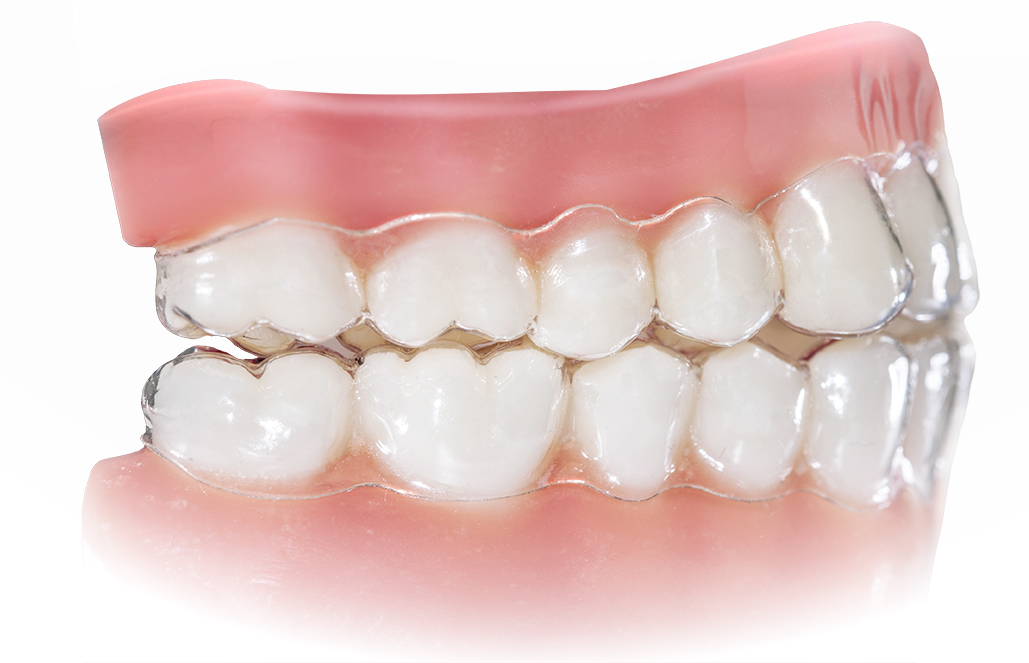
CLEAR ALIGNER
RETAINERS
A retainer is intended to consolidate the effects of orthodontic treatment using a fixed appliance. It is assumed that the retention stage can last up to several years.
The duration of treatment is estimated to be at least 3 years and depends on many factors:
- the type of treatment previously used
- degree of malocclusion
- genetic predisposition
- patient’s age – the older the patient, the longer the retention time and the more difficult the results
Vacuum formed retainer – removable retainer
The removable retainer is a transparent rail made individually for each patient from thermoformed materials made under pressure. For the first months after removing the fixed appliance, the retainer should be used day and night and removed only for eating and brushing teeth. Then, after a time specified by the doctor, it is worn only at night. The dentist decides whether to reduce the frequency of wearing the retainer.
Retainer wire – fixed retainer
The retainer takes the form of a thin wire glued to the lingual surfaces of the front teeth. It does not require cooperation from the patient, only care when cleaning teeth in this area.
Orthodontic treatment – course
Orthodontic treatment is a complicated process and consists of several stages.
- A consultation visit to the orthodontic practice, where the orthodontist is acquainted with the patient’s expectations and the condition of their teeth and occlusion. Full diagnostics is performed on the basis of pantomographic X-ray or X-ray cephalometric images.
- The next step is a visit before the appliance is put in, during which dental hygiene is performed and impressions for diagnostic models and photos of the face and teeth are taken.
- Setting up the appliance: fixing the brackets on front and side teeth, and attaching an orthodontic archwire.
- Check-up visits, during which the appliance is adjusted, while archwires, springs and elastic brackets are replaced. Each visit is intended to provide the teeth with the right conditions so that they can move to their target place.
- Removal of the device: after the orthodontic treatment is completed, the device is removed.
- Dental hygiene treatment to clean teeth after orthodontic treatment.
- The retention stage, which consists in the selection of a vacuum formed retainer and/or establishing retainer wire.
Frequently asked questions
Is orthodontic treatment painful?
Minor pain may occur when correcting defects with fixed and removable appliances, lasting no more than 2-3 days after the visit. In most cases the feeling is not painful enough to require a painkiller, although it should be remembered that pain sensation is an individual matter.
Does wearing a fixed appliance cause a speech impediment?
The device is a foreign body in the mouth, therefore, for the first days after its application, patients may have trouble speaking clearly. When the patient gets used to it, everything goes back to normal.
How long does it take to put on a fixed appliance?
The application takes about an hour for one arc to one and a half hours for two arcs.
Do the correction results last a lifetime?
There is no risk of the defect recurring, although it is possible that a slight displacement of the teeth, not affecting the aesthetic effect, may occur. To prevent potential relapse, special retainers are used.
Does the orthodontic appliance make it difficult to speak?
Immediately after inserting the appliance, you may experience problems with smooth, clear speech. However, these inconveniences quickly disappear as you become familiar with the appliance.
Are there any limits regarding the age of the patient when setting up the appliance?
No, there are no age limits. However, one should bear in mind that adult orthodontic treatment may take longer.
Does the appliance make eating difficult?
For the first few days after inserting the appliance, we advise you to choose soft, easy to chew dishes. We advise against consuming crunchy, hard products (apples, carrots, bread crusts) and chewy products (fudge, chewing gum) throughout the period of wearing the orthodontic appliance.
What happens when a bracket detaches from the tooth?
Sometimes it happens that a bracket or ligature will peel off (for example after eating something chewy or hard). Usually, this is not a situation that requires an immediate visit to an orthodontist (unless the patient complains of pain or discomfort). If the bracket has not come fully loose, leave it. If it has peeled off, make an appointment and take it with you.
What if ligatures fall out?
In this situation, please contact the dental practice. You will probably need a dentist to intervene.
Is it true that it is not possible to perform dental hygiene treatment when wearing an appliance?
Absolutely not! In the case of wearing the appliance, dental hygiene treatment is recommended as often as every 3 months. Patients who opt for orthodontic treatment should remember that when using an orthodontic appliance proper oral hygiene is of great importance and can contribute to the success of the treatment.










